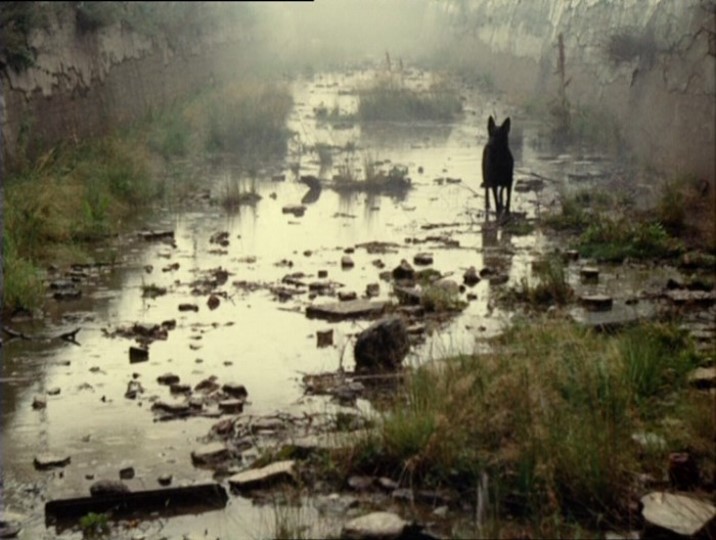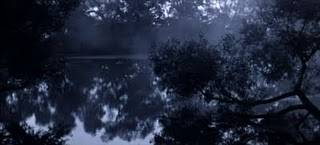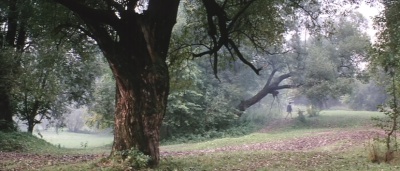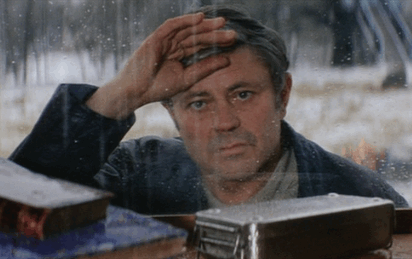From the Chicago Reader (September 15, 2000). It’s delightful to report that this film is now available in the U.S. from Icarus Films. — J.R.
One Day in the Life of Andre Arsenevich
Rating **** Masterpiece
Directed and written by Chris Marker.
Industry flacks claim that Hollywood movies have been dumbed down out of commercial necessity — they’re just giving audiences what they want. I don’t buy it. Audiences aren’t being offered intelligent movies, or at least those aren’t the ones getting multimillion-dollar ad budgets. This was especially the case during the past summer, though as usual, most of the press tolerantly excused the fare as standard silly-season stuff — as if we and not the industry and their advertisers were responsible. The flacks may love to shift the blame by telling us how dumb we all are, but their contempt finally may be causing a minor counterreaction.
Difficult, demanding, and incorrigibly serious art movies have been becoming more popular — though that may be less the result of a backlash against Hollywood than of a growing awareness that the makers of art movies are more respectful of the seriousness, intelligence, and spirituality of moviegoers. The first solid indication of this trend I noticed was the nationwide success of the Robert Bresson retrospective, which came to the Film Center in the spring of 1999 and drew enough crowds to warrant a partial revival of the series a few months later. Another was that, according to Stephen Holden in the New York Times, the belated New York theatrical premiere of Krzysztof Kieslowski’s ten-part, ten-hour Decalogue (1988) this past summer earned $247,711 during its eight-week run at the Lincoln Plaza, occasioning a repeat engagement downtown that’s still going. And Brian Andreotti, who books films at the Music Box, recently told me that the reason Abbas Kiarostami’s The Wind Will Carry Us won’t arrive in Chicago until December 8 — well over a year after it opened in Tokyo and Paris, and two months after its premiere in Buenos Aires — is that it’s been doing so well in New York that he wanted it to play here for at least three weeks, which wouldn’t be possible until the Christmas season. (Decalogue will be playing then on the Music Box’s other screen.) Kiarostami’s poetic comedy has more offscreen than on-screen characters, and whole sections of the plot are left up to the viewer’s imagination, which has led some critics who generally operate as Hollywood apologists to chide Kiarostami for being self-indulgent — though he’s simply refusing to create the kind of trash they’re used to reviewing. The best way to make poetry more attractive in any culture may be to suppress it; this hasn’t happened here in any literal way, but the industry’s and the media’s assumption that we’re all unpoetic lunkheads who only want to see movies such as X-Men was bound eventually to drive us back to poetic work.
Here’s another example of that shift. According to Martin Rubin, who joined the Film Center last February as its new associate director, the biggest crowds he’s seen there since he arrived have been at the Andrei Tarkovsky retrospective in July. Since almost all of Tarkovsky’s oeuvre is available on video — I believe the major exception is his 1983 feature Nostalghia — the people who went to see these works could have seen them on their own, but they turned out instead for the big-screen communal event.

I didn’t make it to any of the screenings, though if I’d been going to movies strictly for pleasure, I probably would have attended most of them. I’ve seen all seven of Tarkovsky’s features, some of them several times, but I’ve never felt anywhere close to exhausting them. I haven’t seen Andrei Rublev (1966) for a good quarter of a century, and The Mirror (1974) struck me as almost completely opaque the single time I saw it. I also have to confess that most of Stalker (1979), now my favorite, infuriated me when I first saw it in the early 80s. With the possible exception of My Name Is Ivan (aka Ivan’s Childhood, 1962), Tarkovsky’s first feature, all of his movies qualify to some degree as head scratchers. The same goes for the best films of Kieslowski and Kiarostami. As Chris Marker puts it, some filmmakers deliver sermons, but “the greats leave us with our freedom.”
If we emerge from Tarkovsky’s films somewhat puzzled, this is only the first of the special gifts they have to offer, for ultimately they aren’t so much mysteries to be solved as experiences to be interpreted, learned from, and assimilated. Marker notes that human levitation figures in at least three Tarkovsky films — Solaris (1972), The Mirror, and The Sacrifice (1986) — but has a narrative justification only in the first, when the characters are in free-fall in a space station. This doesn’t make Solaris an easier film to understand than the other two, because the narrative justification winds up clouding more issues than it clarifies; Tarkovsky himself once suggested as much by implying that Solaris was compromised by its relation to science fiction. I should add that it was mainly my generic expectations of Stalker, his other so-called science fiction film, that initially infuriated me. Tarkovsky once avowed that the only genre that truly interested him was film itself. “The true cinema image is built upon the destruction of genre, upon conflict with it,” he wrote in his book Sculpting in Time, adding that filmmakers such as Bresson, Antonioni, Fellini, Bergman, Kurosawa, Dovzhenko, Vigo, Mizoguchi, Buñuel, and even Chaplin created their own genres and that “the very concept of genre is as cold as the tomb.”

Marker’s 55-minute video One Day in the Life of Andre Arsenevich — showing this Friday at Columbia College and on Saturday at Chicago Filmmakers — was made last year for the excellent French TV series “Cinema de notre temps” (“Film in Our Time”). It’s the best single piece of Tarkovsky criticism I know of, clarifying the overall coherence of his oeuvre while leaving all the principal mysteries in the films intact. It becomes clear early on that Marker was an intimate friend of Tarkovsky and his family, and was shooting home-video footage of some of Tarkovsky’s final days in the mid-1980s, when he was dying of cancer, for Tarkovsky and his family’s use as well as his own. But this is handled throughout with exquisite tact and restraint and is never allowed to intrude on the poetic analysis of the features. In fact, the video interweaves biography and autobiography with poetic and political insight in a manner that seldom works as well as it does here, perhaps because personal affection and poetic analysis are rarely as compatible as Marker makes them.

Marker tapes Tarkovsky’s wife Larissa commenting on a downpour she’s been caught in, amusedly comparing it to the rain in Stalker, and then he has his narrator remark, over an appropriate selection of Tarkovsky clips, “It rains a lot in Tarkovsky’s films, as in Kurosawa’s — one of the signs, no doubt, of the Japanese sensibility he mentioned so often. And like the Japanese, a physical relationship to nature. There’s nothing more earthy, more carnal than the work of this reputed mystical filmmaker — maybe because Russian mysticism is not that of Catholics terrified by nature and body. Among the Orthodox, nature is respected, the Creator is revered through his creation, and in counterpoint to the characters, each film knits a plot between the four elements — sometimes treated separately, sometimes in pairs. In The Mirror, a simple camera movement brings together water and fire…the opposite path in Solaris.”
Discussing the work of any filmmaker in relation to the four elements sounds like a facile activity; I recall, for instance, a rather absurd monograph published in England in the 60s or 70s that enumerated earth, air, fire, and water images in the films of Martin Ritt. But Marker persuades me that it’s a wholly functional means of getting at what Tarkovsky’s films are doing and at the relationship they have to one another. With a similar clinching simplicity, Marker compares what he calls the archetypal camera angle of Hollywood (slightly low, framing people against the sky) with the archetypal camera angle of Tarkovsky (slightly high, framing people against the ground), then lets all the metaphysical implications of this difference sink in.

Marker’s criticism is on video rather than on film or in print — including The Last Bolshevik (1993), his portrait of the late Alexander Medvedkin, another Russian filmmaker friend — which seems to justify a claim Godard made to me in a 1996 interview, that criticism “is the only thing video can be and should be.” Unfortunately, Godard’s own supreme effort in this realm — the eight-part video series Histoire(s) du cinema, completed a couple of years ago — remains unseen in the U.S. because its distributor, Gaumont, has cleared the rights to the film clips and artwork it uses only in France. (As partial compensation — apparently the rights to film sound tracks and musical samplings don’t need the same kind of clearance — ECM has issued the complete sound track on CD in an expensive boxed set, along with books reproducing most of the spoken and written texts in three languages.)
Perhaps for similar reasons, most of the programs in “Cinema de notre temps” are rarely available outside of France. Yet we’re getting to see Marker’s comparatively straightforward and fully accessible masterpiece fairly promptly, maybe because he had to get clearance for clips from only a few films and for a video record of Tarkovsky’s London staging of Mussorgsky’s Boris Godunov. It may also be relevant that Marker is bilingual — he has issued graceful French and English versions of most of his major films and videos since Sans soleil in 1982 — and that he’s a compulsive globe-trotter, even though he keeps a low profile.
Characteristically, the first-person narration in One Day in the Life of Andre Arsenevich, written by Marker, is delivered by Alexandra Stewart, the Canadian-born, Paris-based actress who performed the same function in the English version of Sans soleil (similarly, Michael Pennington, not Marker, was the first-person narrator in The Last Bolshevik). And characteristically he has refused to assign himself — or anyone else — a directorial credit, modestly crediting himself with “video footage,” “narration,” and “editing.”
The title plainly alludes to Aleksandr Solzhenitsyn’s 1962 novel One Day in the Life of Ivan Denisovich, about life in a Stalinist labor camp. Marker recounts that Tarkovsky experienced “20 years of harassment of every sort” from the Soviet authorities, though he wasn’t a political dissident but merely a Russian mystic and an unconventional filmmaker. That harassment eventually drove him into exile in Europe, and when his son and mother wanted to join him they were denied visas for five years. (Practically the first thing we see in the video is Marker’s footage of Larissa tearfully greeting the two at the airport.) Charting Marker’s continuing disillusionment with Soviet communism, the implicit subject of The Last Bolshevik, this companion piece also evokes what might be described as his philosophical wanderlust in other respects — as evidenced, for example, by his passing gibe at “Catholics terrified by nature and body.”
Attempting to explain an artist’s life through his work and vice versa is perilous, yet Marker has adopted this method throughout One Day in the Life of Andre Arsenevich. I think he gets away with it because his essayistic manner demonstrates that his acquaintance with both Tarkovsky and his films is sufficiently deep to trace the connections without making too much of them. The only possible exception is when he cuts between the title character of Stalker in bed describing his despair about humanity and Tarkovsky in his own sickbed, though it’s hard to dismiss the autobiographical undertones of the Stalker’s monologue.
More generally, Marker is content to leave ambiguities hanging. But how he leaves them hanging is of utmost importance — and is the source of his greatness as a writer and video artist. He wittily recounts a seance Tarkovsky once attended at which Boris Pasternak allegedly informed him, correctly, that he would make only seven films — “but good ones.” (Jacques Tati made only six, all good as well.) Even more ambiguously, Marker points out that the first scene of Tarkovsky’s first film shows a child standing by a young tree whereas the last scene of his last film shows a child lying at the foot of a dead tree. This implies that Tarkovsky had a remarkable singularity of purpose — Marker adds that when Tarkovsky shot the later scene he didn’t even know he was ill — but the viewer is left to decide what it means.

Marker isn’t just interested in such symmetries; he’s equally concerned with bits of whimsy, such as Tarkovsky adapting Ernest Hemingway’s “The Killers” in one of his early student films — occasioning some interesting rhymes with Robert Siodmak’s 1947 noir version — and Tarkovsky’s cameo appearance in the same film, whistling “Lullaby of Birdland.” Lives are made up of relevancies and irrelevancies alike, and Marker has the good sense to be attentive to both.
At one point he takes off from the premise that the house in The Sacrifice is a character, noting that in other films Tarkovsky was building an “imaginary” and “unique” house “where all the rooms open into one another and all lead to the same corridor. Opening a door by chance, the actors of The Mirror could cross paths with those from Nostalghia.” This eventually drifts into a discussion of the literal houses Tarkovsky lived in, but I think Marker is alluding mainly to the house he himself is building — a kind of meeting place for Tarkovsky’s various films that also contains several passageways between life and work. It’s the kind of utopian space that has particular resonance in the work of Marker, so it seems only fitting that he should find parts of the cumulative wisdom of his own life reflected in the ecstatic visions of his Russian friend.







